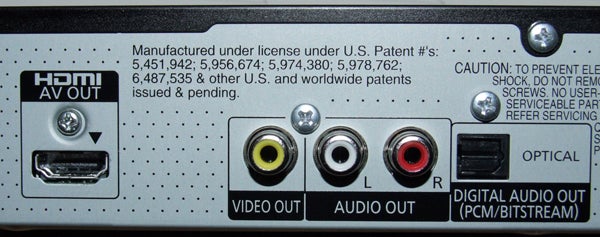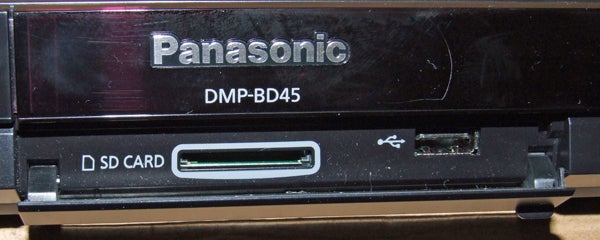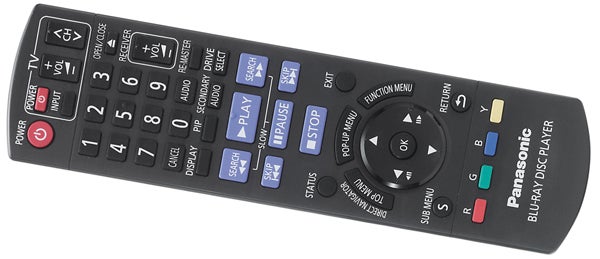Panasonic DMP-BD45 Blu-ray Player Review
Panasonic DMP-BD45 Blu-ray Player
The Panasonic DMP-BD45 brings the company's Blu-ray players into the realm of affordability.

Verdict
Pros
- Very slim
- Excellent picture quality
- Crisp hi-def pictures
Cons
- No Ethernet terminal
- Slow to load discs
- Lack of BD Live functionality
Key Specifications
- Review Price: £169.99
- Built-in 802.11n Wi-Fi support
- DLNA networking
- Supports SDHC and SDXC cards
- USB port
- HDMI output
Every year we look forward to Panasonic’s new Blu-ray players like a kid looks forward to Christmas, but this year’s range has inspired new levels of excitement. Why? Because the four-strong 2010 line-up not only adds all the snazzy features offered by its Korean rivals, but it also includes the company’s first 3D-capable deck, the DMP-BDD300. The 3D deck is out later in the year, but March sees the launch of three lower-specced but no less appetising hi-def players, the DMP-BD85, DMP-BD65 and DMP-BD45.
However, we’re easing ourselves in gently with the entry-level DMP-BD45, which comes equipped with a basic feature list at an attractive price, giving buyers on a tight budget a chance to sample some of Panasonic’s lauded picture prowess. The step-up model, DMP-BD65, adds Wi-Fi support among other networking features for a £30 premium, while the next one up, DMP-BD85, costs around £300 but offers ‘high-grade’ electronics, built-in 802.11n Wi-Fi support, DLNA networking and everything else you could ever want from a Blu-ray deck (except 3D, of course). Look out for a review of the BD85 next week.![]()
Like previous Panasonic decks, the BD45 is a fairly unremarkable looking piece of kit. Nothing jumps out or catches the eye in the same way as the Philips BDP7500, and the non-glossy black finish is tasteful but uninspiring. However, there’s still much to admire – the unit feels well made, is improbably slim and the display panel is large and informative, showing the elapsed time in large illuminated digits.
Below the disc tray is a thin flap that conceals an SD card slot and USB port – the former supports SDHC cards (from 4GB to 32GB) and SDXC cards (from 32GB to 2TB) and lets you view JPEG pictures or AVCHD footage shot on HD camcorders, while the latter offers a way of playing DivX, MP3 and JPEG files.
On the back, sockets are stripped down to the basics, and we mean basic – you get HDMI, composite, analogue stereo and optical digital audio outputs, and that’s your lot. No multichannel analogue ports, no component out and most remarkably of all, no Ethernet terminal.
The last one is a curious omission – it makes this a Profile 1.1 player, and as such doesn’t allow you to access BD Live content. We realise that not everyone likes BD Live, and it’s clearly been omited to keep costs down, but with similarly-priced players from the likes of Sony and Samsung that do support it, this isn’t a compromise you should have to make. We’re also curious to know how Panasonic has managed to launch a new Profile 1.1 player when we thought the minimum spec was Profile 2.0.
The player does, however, perform most of the other tricks you’d expect from a Blu-ray deck. It’ll feed 1080p pictures to compatible TVs at their native 24Hz frame rate, and outputs Dolby TrueHD and DTS HD Master Audio in bitstream form to an AV receiver, or converts them to PCM for receivers without the relevant decoding. The lack of multichannel analogue outputs makes this the only way of enjoying hi-res movie soundtracks.
Despite being the baby of the bunch, the BD45 still comes equipped with the same picture technology (developed by Panasonic Hollywood Labs) found on the company’s previous players. We’re sure you’re familiar with these, but to recap they include a new version of P4HD, which processes 15 billion pixel per second and optimises each one to ensure the best possible detail and colour reproduction. It’s also responsible for motion detection, diagonal line processing (eliminating those pesky jaggies) as well as 1080p upscaling for DVDs.
Then there’s PHL Reference Chroma Processor Plus, which works alongside high precision 4:4:4 signal technology to process colour data, which is said to achieve greater accuracy than other systems.
Elsewhere the deck plays an unusually wide range of disc types, including BD-R/RE Freesat recordings made on Panasonic’s Blu-ray recorders, DVD-RAM and dual-layer DVD-R. And despite the lack of BD Live support, the BD45 does support BonusView, so at least you’ll have access to picture-in-picture commentaries.
Poking around in the onscreen menus unearths more goodies. Hit the Display button and a menu banner appears at the top of the screen, with Disc, Play, Picture and Sound headings. Under Picture, you get a choice of presets (Normal, Soft, Fine and Cinema) as well as a User setting that lets you adjust seven different picture parameters and Detail Clarity, which gently enhances sharpness. Under Sound, you can choose from a range of presets (Night Surround and several Re-Master modes that boost high frequencies) and Dialog Enhancer.
People either love or hate Panasonic’s bright, brash onscreen design, but we’ve always been big fans. There’s no ambiguity – most options are placed exactly where you expect them to be and the setup menu doesn’t get bogged down in excessive submenus and fussy layouts. Initial setup is a breeze thanks to the Easy Setting wizard that appears when you first boot up.
Panasonic has made some subtle tweaks to the Functions menu since last year’s BD60 and BD80, but nothing major – the icons are larger and the ‘To Others’ option has been moved to the bottom. It’s slightly annoying that the Setup menu isn’t listed in the Functions menu (you have to select ‘To Others’, then ‘Setup’ in a superfluous box) and accessing it makes you lose your place in the movie, but otherwise it’s a very intuitive and responsive GUI.
Aside from the lack of a backlight, the BD45’s remote is impressive. All of the buttons are labelled in big, shouty letters and the most frequently used keys are clustered together under the thumb.
Previous Panasonic players have been slow to load discs and little progress has been made on that score since the BD60 and BD80. To test it, we put a disc in the tray and started the clock when we hit Close, then stopped it when the first menu or moving video appeared. Spider-Man 3 took 59 seconds to load and Terminator Salvation took a whopping one minute and eighteen seconds, which harks back to the early days of the format.
Still, at least the deck doesn’t take an age to boot up – with Quick Start, it’s up and running in five seconds, with the usual caveat that the player consumes more power in standby. With Quick Start turned off the deck boots up in around 15 seconds, which still isn’t bad.
The BD45 delivers excellent picture quality, particularly for a player at this price point. With a decent 1080p transfer like ”Inglourious Basterds”, it reproduces images with lucidity and subtlety such that you’d swear you were watching it on a more expensive player. Check the scene where Col. Landa pulls up outside Monsieur LaPadite’s house. Colours are truly radiant yet natural, while the detail that defines shadows within the bushes and trees is superbly drawn, giving the image plenty of punch and depth.
The subsequent scenes inside the dimly-lit house reveal more of the deck’s excellent contrast balance and shadow detail. We’ve viewed these scenes on several players recently, including the Philips BDP7500 and Sony BDP-S760, but the BD45’s treatment boasts a touch of extra sharpness and insight, which we can only attribute to the processing effects of P4HD.
We couldn’t stump the BD45 with the Silicon Optix HQV disc either. Its handling of every test is flawless – particularly impressive is the level of focus it brings to the edges of the rotating bars on the jaggies tests, and its ability to lock down the Video and Film Resolution cadences without so much as a single twitch or flicker. DVDs obviously lack the pizzazz of hi-def but look great, upscaled with smooth edges, terrific detail rendering and convincing colours.
Sonically the BD45 does a workmanlike job, tackling Corinne Bailey Rae’s ”The Sea” on CD with plenty of verve and top-end detail, and it just about nails the fragility of her vocals, but we’ve heard better. No problems with HD audio tracks though – the sound is as explosive as you’d expect.
Verdict
Anyone who dreamed of owning a Panasonic Blu-ray deck but found their prices too prohibitive can now get themselves one, albeit a vanilla version. Thanks to Panasonic’s ever-reliable, PHL-developed processing, the DMP-BD45’s picture quality is exceptionally good for a sub-£200 model, and if crisp hi-def pictures is the only thing you want from your Blu-ray experience then the BD45 might be worth a punt.
However, the curious lack of BD Live functionality proves to be the BD45’s biggest obstacle. While we appreciate Panasonic’s attempts to cater for budget buyers, getting rid of BD Live altogether isn’t a wise move, even on an entry-level deck like this. Even if your feelings towards BD Live are ones of overwhelming indifference, buying a player without it is like cutting off your nose to spite your face. Our advice? Save up an extra £30 and bag yourself the DMP-BD65…
Trusted Score
Score in detail
-
Performance 9
-
Design 7
-
Features 7
-
Value 7

